Author: Yinghao, Investor at SevenX Ventures, Twitter @linsajiao
Social media is too important to be controlled by a few corporations. Were building an open foundation for the social internet so that we can all shape its future.——Bluesky
TL;DR
Bluesky and AT Protocol are a new generation of social media platforms and protocol layers, with protocolization, openness, and anti-censorship as core value propositions.
Bluesky is AT Protocols flagship product, featuring personalized information flow, community-driven review, user identity and data ownership.
Bluesky has mastered the KSF model for social media products and achieved early growth flywheel through effective operations. It now has 12 million registered users.
The AT Protocol ecosystem is developing rapidly. There are more than 100 projects and components from community developers, and many high-quality projects have achieved cold start by leveraging the user network.
Young users need new platforms. We are optimistic about the new generation team with Jay and Rose as the core and the huge potential they bring in terms of open protocol product ecology, super applications, new business models and token economy.
1. A Moveable Feast: The Eternal Myth of Social Media
Eternal Myth and a Moveable Feast
In the years of crypto investment, social media is a topic we have been paying attention to. It is very tempting because social media is the source of user networks and has super scale effects and commercial value. We regard social media as a non-technical disruptive innovation:
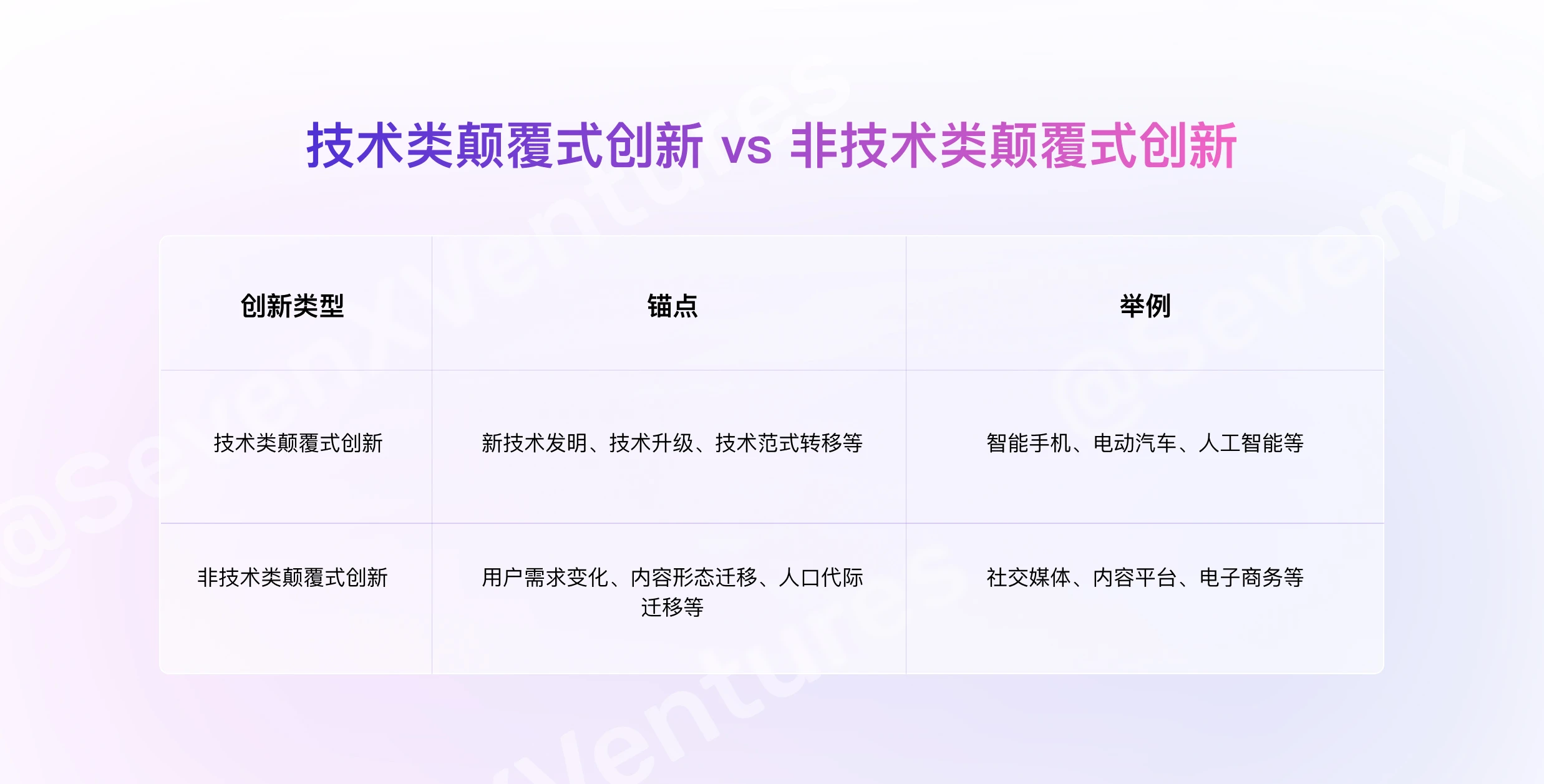
However, in the process of research and investment practice, we found that it is difficult to have an in-depth and effective discussion on social media - social media products are like politics, everyone can comment on them, but it is difficult to really explain them clearly. The discussion about them will never stop. The perspectives of thinking about social media products are complex and it is difficult to form a unified logical framework. We believe the fundamental reasons are as follows:
The real boundaries of social media are far beyond the product. It is more like a social public tool in the information age, a collection of era elements such as ideology, values, politics, culture, social events, business and technology. It often starts with a simple product + a simple user group, but when it grows into a behemoth, it has become the Ship of Theseus;
Social media is a scale for the evolution of human civilization, and it also has a reflexive effect on it. We use it to understand what is happening, and it also records the real level of human civilization in real time, and reversely outputs and manipulates a considerable number of groups. We cannot discuss our own mirror image from a higher perspective, but can only dance with it.
These reasons make social media products very different from other products, but also because of this, social media is a moving feast: a series of flowing platforms, carrying the ironclad needs of users. Users are always skeptical of old products and looking forward to new products, and they hold the votes to elect the new king at any time; developers and investors can always expect a homerun-style rich return every few years.
Why pay attention to Bluesky
We recently participated in the investment of Bluesky, a new generation of social media. Its representative vision and concept helped us think about this issue again. We would like to talk about the significance of Blueskys existence and its potential based on our own understanding.
Bluesky describes its positioning and vision as follows:
“Bluesky is a social app that is designed to not be controlled by a single company. We are creating a version of social media that is built by many people, but still fits together into a cohesive, easy-to-use experience.
We hope that modern social media and online public conversations will be more like the early days of the web, when anyone could set up a blog or subscribe to multiple blogs using RSS. We believe this will usher in a new era of experimentation and innovation in social media. Researchers and the community will be able to step in to help solve the problems currently facing social networks, and developers will be able to experiment with many new forms of interaction.
Traditional social networks are typically closed platforms with a central authority. There is a small group of people who control these companies and they have complete control over how users use the platform and what developers can build. On these platforms, as a user, if you try to leave, you have to start from scratch without the connections you made there or the content you produced. As a developer, if you try to build a new app, you have to overcome network effects and rebuild the social graph from scratch, and if you try to build on top of these companies’ APIs, they can cut you off and kill your company in the blink of an eye. As a creator, you might spend years building an audience, but when the platform changes the rules for you, you lose access to that audience.”
In an early Bluesky declaration, we noticed that Bluesky established Bluesky PBLLC in 2022 as a PBC (Public Benefit LLC), reaffirming their original intention when they were founded in 2019: Our mission is to develop and promote the large-scale adoption of open and decentralized public dialogue technology.
From a broader time perspective, the timing of Bluesky’s birth is very interesting, and at the same time, it is very unique and representative.
In 2019, when Bluesky was officially established, global geopolitics and ideology fluctuated frequently. We can clearly recall the United States withdrawal from UNESCO, the Intermediate-Range Missile Treaty, and the Paris Climate Agreement, the United Kingdoms decision to leave the European Union, Russias increased diplomacy in the Middle East, Asia and Africa, Huaweis inclusion in the Entity List, and nationwide riots in Latin American countries such as Argentina, Chile and Bolivia. These black swan events are the most in the past decade, which has led to a concentrated fermentation of ideological conflicts on social media.
Switching the lens, in the following 2020-2021, Web3 ushered in the DeFi summer and another round of bull market, and pushed the proposition of blockchain + large-scale application to practitioners. The earliest batch of decentralized social developers began to take action and made in-depth thinking on the way of information distribution. Our other portco RSS3 is one of the representatives. They take the information distribution model as the main starting point, focusing on those users who still maintain their own habits of searching and organizing information - they still maintain their own requirements for the quality and accuracy of information acquisition through active search, subscription, unfollowing, filtering, etc., and use this as a starting point to dig deep into the two distribution models of editor based distribution and self based distribution, which is also the early narrative of RSS3. This direction coincides with the custom feeds+algorithms marketplace proposed by Bluesky later. Obviously, since then, the concept and technology of decentralization have seriously touched developers.
When discussing Bluesky, we cannot avoid mentioning its first initiator and funder X (mainly Xs founder Jack Dorsey). The relationship between Bluesky and X is also a testament to this special period in history.
Bluesky was launched as a project by X in 2019 and funded by X. Xs attempt stems from the serious challenge they face: how to balance survival, protecting free speech, and limiting abuse. X has fought a lot with governments in places such as the United States, India, Turkey, Australia, Russia, and Nigeria. Some governments have asked X to provide personal information of accounts and even threatened to arrest employees. The reality is that the platform operates around universal freedom of speech, but freedom of speech is defined by local laws in each country. If a country asks X to delete some accounts, X must delete them because those accounts are classified as illegal. X was forced to launch a function to delete accounts and content by country (this function is still widely used today), but this regional governance method cannot completely solve the problem, so X believes that the solution to the problem is a protocol: because the protocol cannot be controlled, the government cannot handle a node, and there will be no centralized leader that will be knocked down, just like Bitcoin.
With this mission, Bluesky has been around for more than four years. Blueskys representativeness lies in: it is a concrete representation of a supreme concept. The core of this concept is: protecting freedom of speech, anti-regulation, anti-censorship, not being controlled by a single leader/entity, open protocol, ecological, user identity/data ownership protection, etc. This representativeness comes from both the expectations of users and the active attempts of the team. Bluesky is slowly practicing Xs original will.
Another point is that we position Bluesky as a new generation of generalized social media rather than a Web3 social media, which means that it has the characteristics of both Web2 and Web3, absorbing decentralized concepts and technical solutions, and taking mass adoption as the ultimate goal, which is quite unique in the current market. We will explore the possibility of this positioning below.
2. Basic Deduction Method - Concept, Demand and Product
Let us start from the first principles and use the basic deductive method to look at Bluesk’s corresponding concepts, needs and products.
A tale of two systems
X launched Bluesky several years ago and raised the proposition of centralized products vs. open protocols. This proposition quickly triggered a wide range of discussions, and Masnicks Technical Approach to Free Speech is one of the representative discussions. Lets review the discussion on freedom of speech and how technology divides protocols, platforms and the corresponding two systems.
As mentioned above, social media is a measure of human civilization, and users generally believe that it is a tool to accommodate more speech and improve ideas. But in the past few years, as the scale of adoption has expanded, this view has undergone a huge change: many users have begun to believe that social media has become a cesspool of malicious attacks, bigotry, and hatred. Other rapidly fermenting issues include:
Platform review policies are becoming increasingly aggressive, systematically suppressing certain viewpoints
The platform collects user privacy data, and users cannot know its purpose
The platform is used for false advertising
The platform is used for party competition or attacked by the party
The platform has been accused of foreign manipulation of local elections, etc.
To address these challenges surrounding speech content, many solutions have been proposed, including:
Building large-scale content review teams. Companies such as Facebook, YouTube, and X have discussed hiring review teams of thousands of people.
Using artificial intelligence to try to detect controversial content early in the process
There shouldn’t be any moderation at all — at least for platforms of a certain size — so that they are considered part of the public square, etc.
But these methods did not bring good results, so the idea of using protocols to replace platforms was proposed. Many people mistakenly believe that protocolization is a new technical paradigm, but this is actually a development concept that has existed since the early days of the Internet. The early Internet originated from many different protocols: email used SMTP, chat was done through IRC, Usenet used NNTP as a distributed discussion system, and the World Wide Web itself had its own protocol: Hypertext Transfer Protocol, or HTTP.
But over the past long period of time, there have been fewer and fewer new protocols, and more of them are controlled and operated by private entities, because this not only allows for more efficient introduction of new features and bug fixes, but also makes it easier to grow users and commercialize. In other words, the protocols are being used in depth by various oligopolistic platforms and have built walls, locking users in instead of providing interfaces.
Returning to protocolization is a good solution. Instead of handing over the supervision of speech content to a few oligopolistic platforms, it is better to conduct extensive competition. Anyone can design information flows and filters to allow the most effective/popular solutions to stand out. Compared with resorting to a unified censorship system, users will be allowed to determine their own acceptance of speech without having to completely suppress anyone or let the platform itself decide who is allowed to speak. Protocolization has other advantages:
Competition drives innovation, unexpected new features
Users have greater control over their privacy data
New business models beyond user data monetization (traditional advertising model)
In addition to regulation and auditing, another angle is about commercialization, which is a problem that is difficult for the protocol to solve. There is a case that compares the two products Reddit and Usenet and illustrates the commercialization dilemma of the protocol:
Reddit and Usenet are similar in concept, both are collective forums organized around a specific topic. Different groups are called subreddits on Reddit and newsgroups on Usenet.
The difference is that Reddit is a huge public company while Usenet is an open protocol. To access Usenet, users need a content reader client (there are several options) to access the Usenet server. In the early days, this track was dominated by Deja News, which developed one of the earliest web terminals for Usenet; later it added a series of additional features, including a search engine. Operating Usent servers has never been very profitable, and Deja News did not find a business model that could keep them alive, and was eventually acquired by Google.
Another major drawback of Usenet is its low flexibility, especially when it comes to large-scale iterations. Since it is a set of decentralized protocols, any changes to the protocol must be agreed upon by all parties, and even smaller changes often require a lot of work. Setting up a new content group is a fairly complex process. In comparison, the centralized Reddit does not find this a problem at all, and the strong product team can solve any problems very efficiently.
The commercialization problem of platform products is from a completely different perspective: advertising dependence. Jacky Dorsey pointed out in an interview that one of the biggest sources of X’s difficulties is its business model that relies on centralized advertising:
I think the core, worst sin was choosing an advertising model in the first place. We needed a business model. We saw that Facebooks model was really good, so we came up with an advertising program and ran with it. A year after the IPO, we saw growth decline, and the reason for that was declining ad revenue. When youre completely dependent on that, what if a brand like PG or Unilever doesnt like whats happening on the platform, and they threaten to pull the budget thats 20% or so of your revenue? You have no choice. If you take a stand and they pull the budget, the stock market sees that and the stock price goes from $70 to $30. And then youre letting people go. Thats the whole puzzle youre trying to solve.
Jack also pointed out a clear direction when reflecting on this issue:
Well create other revenue lines. Well focus more on commerce. Well focus more on payments. Well focus on everything theyre trying to do now. All of that is what we did before the company was sold. But Ill do it faster because as a private company, you can shut down the advertising business and just do commerce. Just payments. Just do small ads, more like classifieds, which I think is a phenomenal business for a site like X.
Elon Musk is a good reformer, and his will is consistent with Jack Dorsey. After taking over X, Elon challenged its business model, no longer blindly pleasing advertisers (remember what he said to Disney CEO Bob Iger? Because Disney was worried about anti-Semitic speech on the X platform, it threatened to remove advertising from X if X did not take strong measures. Before Disney, Apple, IBM, Coca-Cola, Microsoft and other companies also took the same approach), laid off a large number of advertising sales staff (Xs advertising sales staff accounted for more than 50% of the total number of employees), and at the same time fully promoted the subscription business. Xs revenue will fluctuate, but at the same time it is also telling the market: not only a single advertising model is valid, and there are more business models to explore in social media.
We can see that the difference between protocols and platforms is actually a confrontation between two systems. Borrowing from the perspective of sociology, we can call it elitism vs. technocracy. The opposite of elitism is populism, but the evolution of technology is a better response to elitism from the perspective of populism.

The three-stage rocket of social media and KSF
In addition to the product concept, lets look at Blueskys opportunities from the perspective of the three-stage rocket theory and KSF. We believe that the three-stage rocket of social media is: necessary factors, boosting factors and decisive factors. Each stage of the rocket corresponds to 2-4 key KSFs:
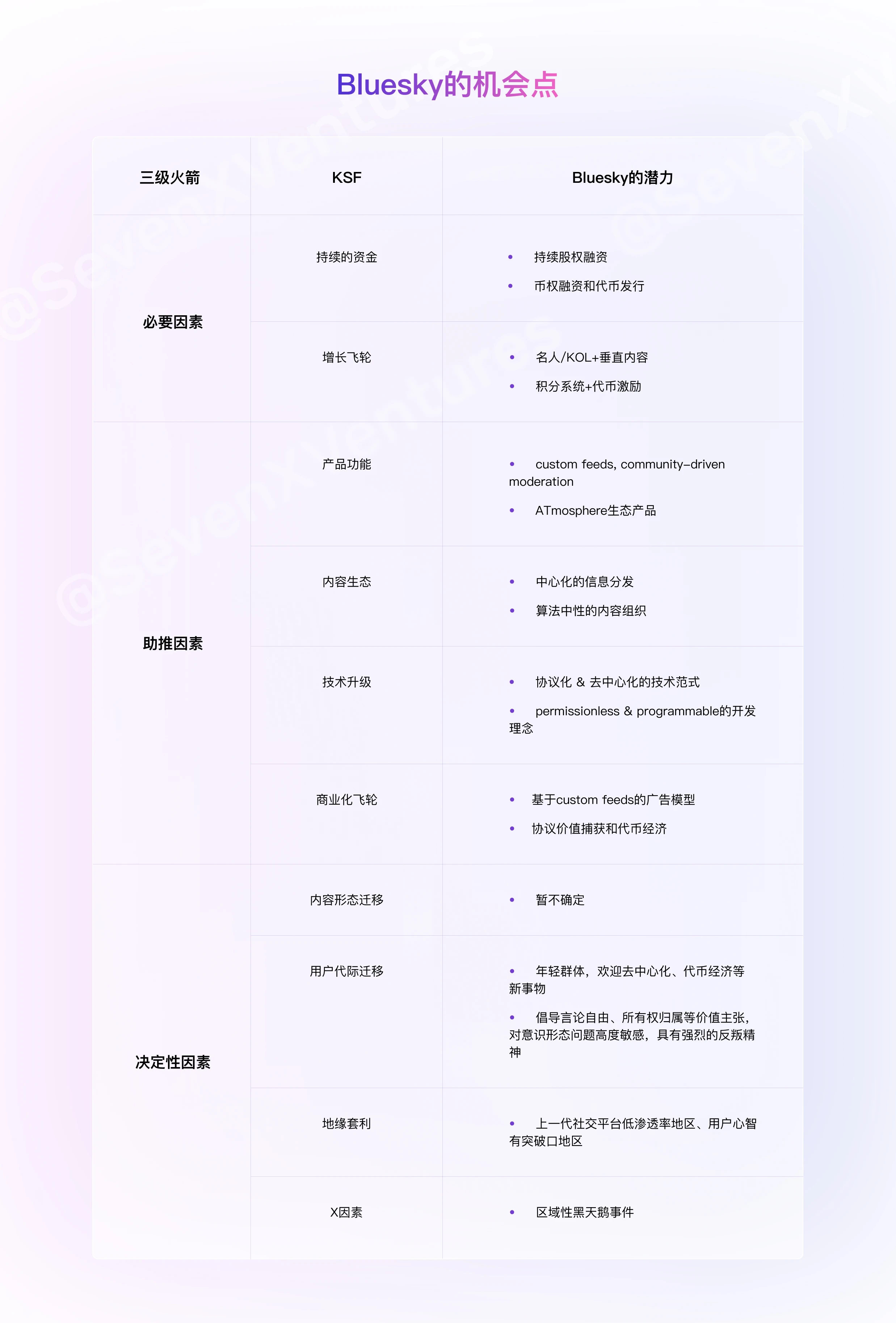
Specifically, among the necessary factors, the two KSFs are:
a. Ongoing Funding:
Before the scale effect is formed, social media has weak monetization ability, but it needs continuous funds to maintain development, operation and user growth, so social media is a capital-intensive business. X raised more than $1 billion in total before listing and raised more than $1.8 billion through IPO. Meta raised more than $1.5 billion in total before listing and raised more than $16 billion through IPO.
After Bluesky transformed from a completely open protocol to a physical company, it is actively conducting equity financing (it could only rely on grants before) and has achieved good results, but it still needs to continue to obtain a large amount of capital injection, so the teams financing ability is very critical. Unlike companies such as X and Meta, Bluesky also has ways to obtain funds through private financing through tokens and TGE public financing. If the two financing channels of equity/tokens work well together, Bluesky is expected to quickly establish a financial advantage.
b. Growth Flywheel:
That is, to continuously acquire customers through effective means and continuously improve the efficiency of capital use. Common methods of traditional social media include: direct purchase of traffic, which has the advantages of abundant customer acquisition channels and stable costs; establishing a content ecosystem through high-quality content to attract vertical users and gradually break through the circle, which has the advantages of low cost and rapid penetration of vertical groups, suitable for early growth; acquiring customers through reward mechanisms, such as affiliate and other fission models, which have the advantages of fast fission speed and high efficiency.
Bluesky has established a mechanism for acquiring customers through celebrities/KOL+ content in the early stage, and has achieved good results. Its greater imagination space lies in acquiring customers through the introduction of a points/token system, which is a Web3 native method. Numerous protocols have verified its effectiveness, but its difficulty lies in distinguishing between real users and incentive-driven users, while avoiding the impact of incentive-driven users on the entire user network.
Among the enablers, the four KSFs are:
a. Product features:
For example, the photo wall on Instagram and the disappearing messages on Snapchat, a truly innovative feature that is adopted by users will make a social product stand out and even drive an unstoppable trend to make it mainstream. Users are always highly enthusiastic and expectant about new features, which is also one of the most popular focus points for developers to find breakthroughs.
Bluesky has a clear foothold in this regard, including custom feeds, community-driven moderation, etc. Its underlying protocol AT Protocol is even more imaginative. It is gradually building a product ecosystem co-created by developers and has dozens of products, and this is just the beginning. The feature innovation brought by the token economy is also exciting and is one of the areas where decentralized developers are best at.
b. Content ecology:
The diverse demands of users for content have supported social media giants in different segments, such as: text + pictures/videos - X, pictures - Instagram, videos - TikTok, and some special content, such as: NSFW-Onlyfans, non-descript content - deep web/dark web. A single social media generally has a clear distinction between content forms.
The content format of Bluesky is not much different from that of X, but the variables of its content ecology lie in the following: i. decentralized information distribution method and ii. algorithm-centered content organization method brought by custom feeds and community-driven moderation. This change has the potential to break through the boundaries of content format and make it a multi-content type platform. AT Protocol developers are also developing new products based on video and live broadcast content.
c. Technology upgrade:
Part of the technology upgrade is related to content, such as the popularization of video content by 5G networks and the birth of online streaming dating platforms such as Omegle; another part of the technology upgrade is related to user experience, such as the recommendation algorithm that dominates the current information distribution model, making users more and more addicted (not a good thing). Web3 is also a kind of technology upgrade, and SocialFi has gradually become a high-potential segment.
Bluesky has a very clear direction for technology exploration, namely the protocolized decentralized technology paradigm, and the permissionless programmable development concept, which will be discussed in the third part.
d. Commercialization Flywheel:
The commercialization path of social media can be summarized as first loss and then profit. The user network relies on intensive funds to build, and the profit model is built on the basis of a huge user network. When social media has a large number of users, there are many ways to realize it, the most common ones are: advertising, subscriptions, value-added services (such as live broadcast rewards), e-commerce, etc. The core of commercialization is to gradually improve capital efficiency and gradually turn negative capital efficiency into positive to achieve comprehensive profitability.
Bluesky has a lot of imagination in terms of commercialization, including: advertising models based on custom feeds, which is a challenge to traditional advertising models; data assetization and transactions based on user data ownership, such as reverse sales to platforms and advertisers; and business models based on token economy, such as the capture of network value by protocols, and the use of tokens as payment currencies within the platform. Innovation in business models will be Blueskys biggest imagination.
Among the decisive factors, the four KSFs are:
a. Content form migration:
The migration process of content formats in social media is very clear: text-picture-video-real-time online content (such as live broadcast and online video matching chat).
The next major content form is still uncertain, perhaps mixed reality, and we believe that Bluesky will not lead the upgrade of content forms for the time being.
b. User generational migration:
Some users are getting older, and some are growing up. This generational mobility of users gives new social media products great opportunities. Facebooks user outflow is a good example, which is why Meta must maintain a high frequency of acquisitions outside of Facebook to retain their users. More than 100 million people in the world become Gen Z every year, and products targeting Gen Z users are one of the most valued opportunities for developers.
Bluesky may become a toy for young people, because whether they are developers or users, young people are not only more receptive to new things such as decentralization and token economy, but also more determined in their value propositions such as freedom of speech and ownership, are highly sensitive to ideological issues, and have a strong rebellious spirit, which is perfect for Bluesky.
c. Geo-arbitrage:
The time machine theory continues to work. Weibo to X, VK to Facebook, TikTok to Douyin are all good examples.
There are also geo-arbitrage opportunities for Bluesky if it can find areas where product X, etc. has low penetration.
d. X Factor:
Including celebrity founders, geopolitics, ideological conflicts, and various black swan events. The impact of X factors can be positive or negative. For example, Xs ban on Trumps account and Pavel Durovs arrest had opposite effects on X and Telegram.
The X factor is unpredictable, but the Bluesky team has proven their ability to harness the X factor: during the time X was banned in Brazil, Bluesky migrated 10% of X users in Brazil, which was undoubtedly a successful sniping.
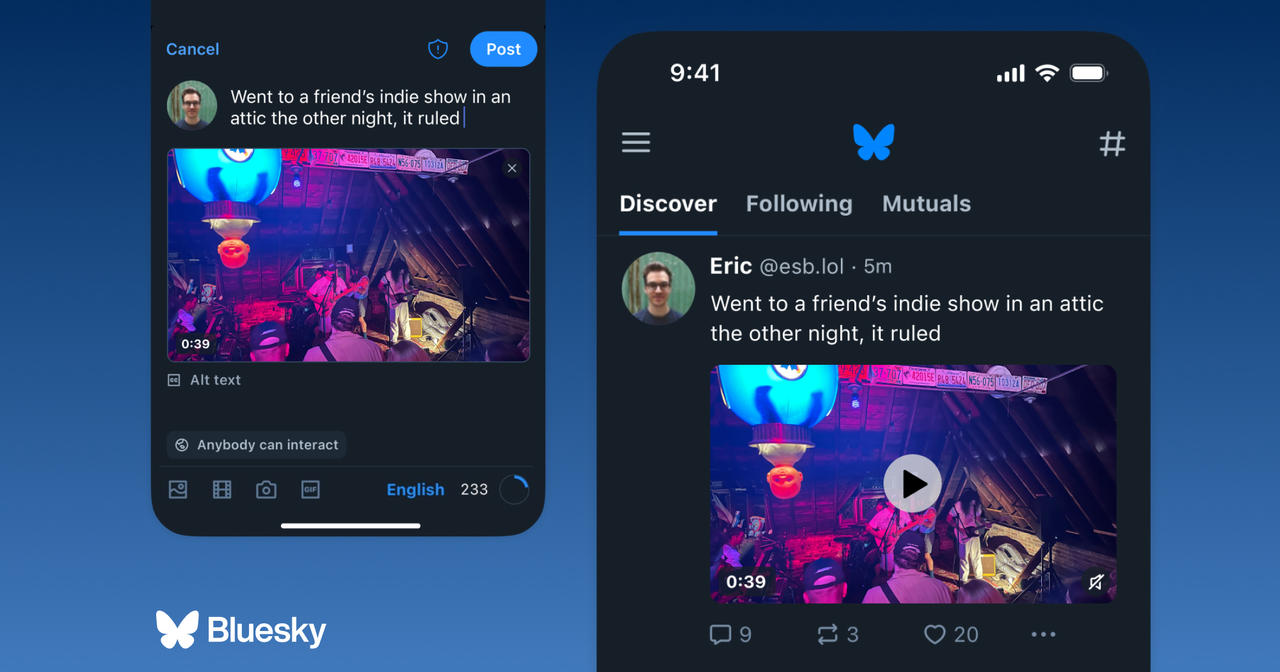
A call from users and developers
The competition between the two systems and the analysis of KSF have made us focus on one question: What kind of innovation is needed on the user side and the developer side? What kind of opportunities are created here? How can Bluesky take them on?
From a medium-term perspective, we can extract three key words: new era, new people and new technology. From a micro-level perspective, we can extract some more specific pain points:
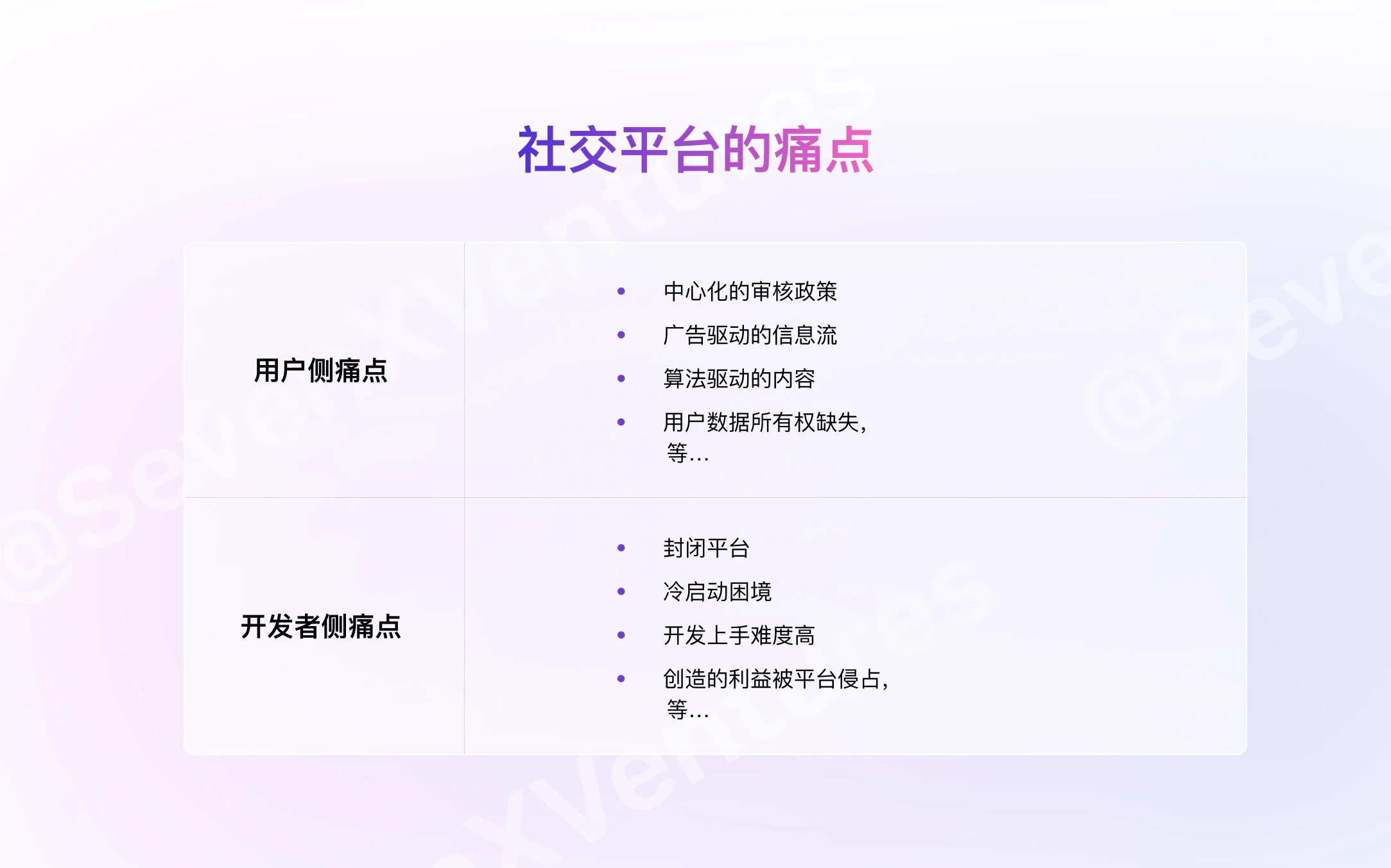
Bluesky provides a complete set of solutions to these pain points.
3. Belly of the Whale - Blueskys attempt
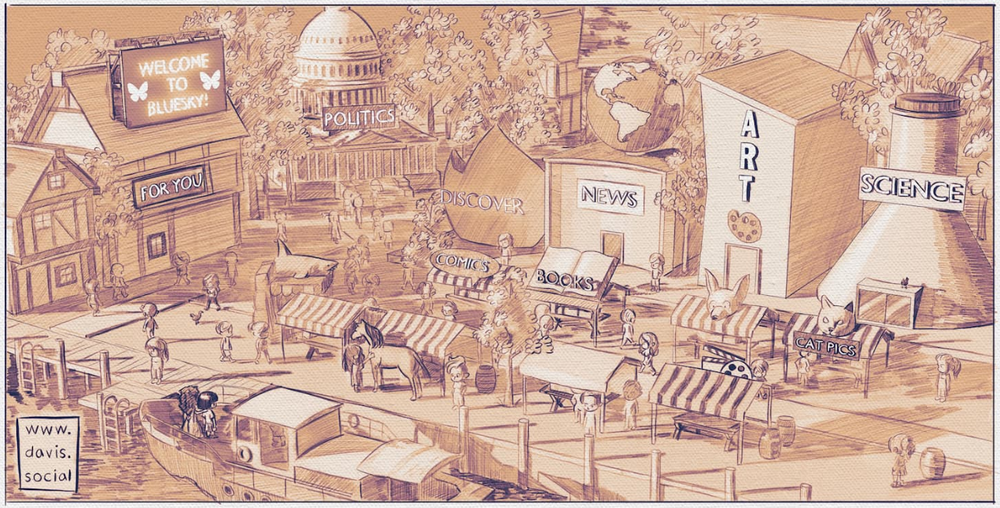
From Bluesky to ATmosphere
In their open letter, Bluesky introduced the three stages they have gone through since their inception.
Initially, Jack Doresy published a manifesto announcing X’s intention to fund the development of an open protocol for decentralized social media, and more than a dozen developers gathered in a chat room that was formed to discuss what should be done. In the initial QA in the room, Jack wrote:
“The biggest long-term goal is to build a durable and open protocol for public conversation. One that is not owned by any one organization, but contributed to by as many organizations as possible. One that was born and developed on the Internet, and follows the same principles.”
Later, Bluesky completed its first fundraising, established a community, and gradually transformed into a company, Bluesky PBLLC, which has been operating as a company until today. Jack Dorseys initial speech pointed out the direction for Blueskys overall roadmap, which can be divided into two parts: Bluesky Portal (product) and AT Protocol (protocol).
Bluesky can be understood as the first portal product on the entire AT Protocol. It is developed by the team itself and is like a permissionless programmable version of X, but it has many new features compared to X (see below). Bluesky is of great significance. It is not only a benchmark product, but also carries the function of accumulating an early user pool for the entire ecosystem. Bluesky has been in operation for more than a year, and the number of users has exceeded 12 million, making it one of the fastest growing social media in history.
AT Protocol is the protocol layer under Bluesky. The team defines AT Protocol as: a protocol for public conversations and an open source framework for building social applications, which means people can transparently understand how it is built and what is being developed. It creates a standard format for user identity, attention, and data on social applications, allowing applications to interoperate and users to move freely between them. It is a federated network with account portability.
To explain with an analogy: every time a user creates an account on a social platform, its like moving to a new city. Users make friends and create posts, which is like filling a house with the furniture they make. But on a centralized social platform, if a user leaves, its like leaving all their friends without being able to connect, and its like leaving their house and not being able to take anything with them. Its very difficult to leave a centralized site and start over. AT Protocol essentially lets people move between cities. Creating a standard format for identity and data is like giving people passports, phones, and property rights. If a user doesnt like the city they initially moved to, they can relocate and take all their belongings (data) with them. Their friends can still find them and stay in touch using the same name and number (identity and follow graph).
According to the Bluesky team, the key points of AT Protocol are:

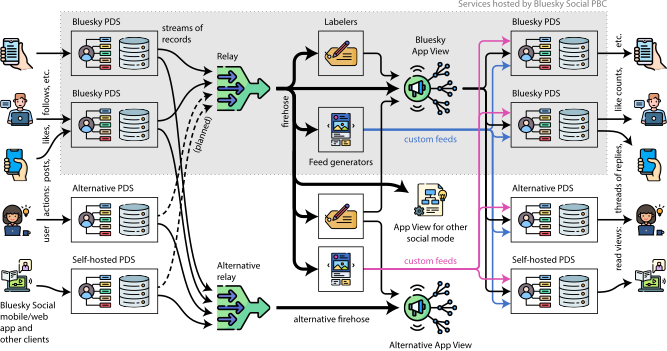
The AT Protocol ecosystem is rapidly attracting developers. According to official statistics, more than 70 projects have submitted content on Github: Project List
The number of community projects and components developed based on Bluesky itself has exceeded 100. In the official Bluesky Showcase column, you can also see projects and components developed using the Bluesky API, including clients, custom feeds, social tools, bots, and other functions.
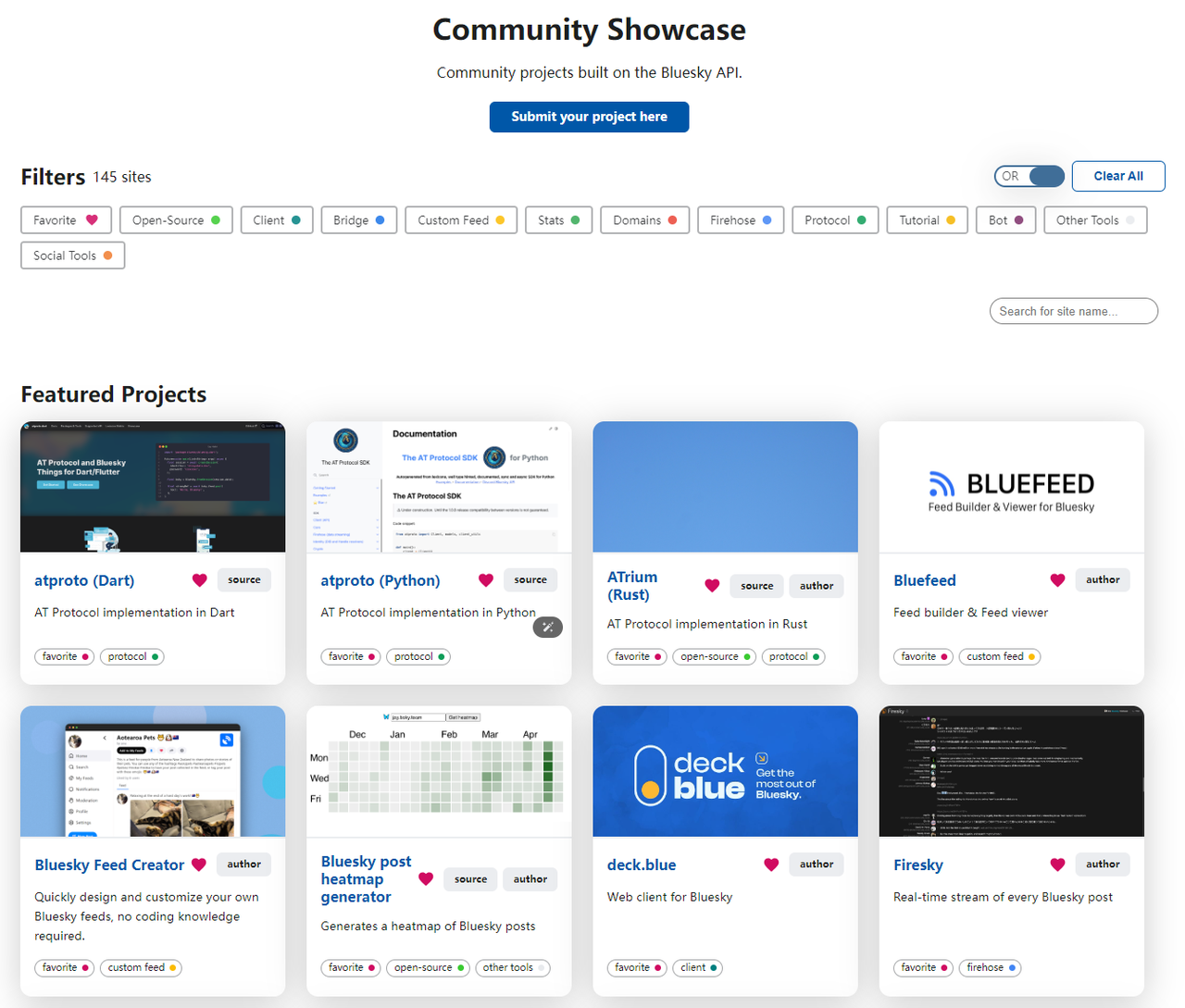
Take deck.blue as an example. This is a typical third-party client developed by the Bluesky Brazilian community. Bluesky users can log in directly using their domain name and password to experience a different UI design and detailed functions: 3rd-party TweetDeck for Bluesky, featuring columns, multi-account, scheduling and inline translations. After the product was launched, deck.blue quickly accumulated users thanks to Blueskys user network.
Bluefeed is a feed search and recommendation tool that makes it easy for users to discover, browse and retrieve various feeds.
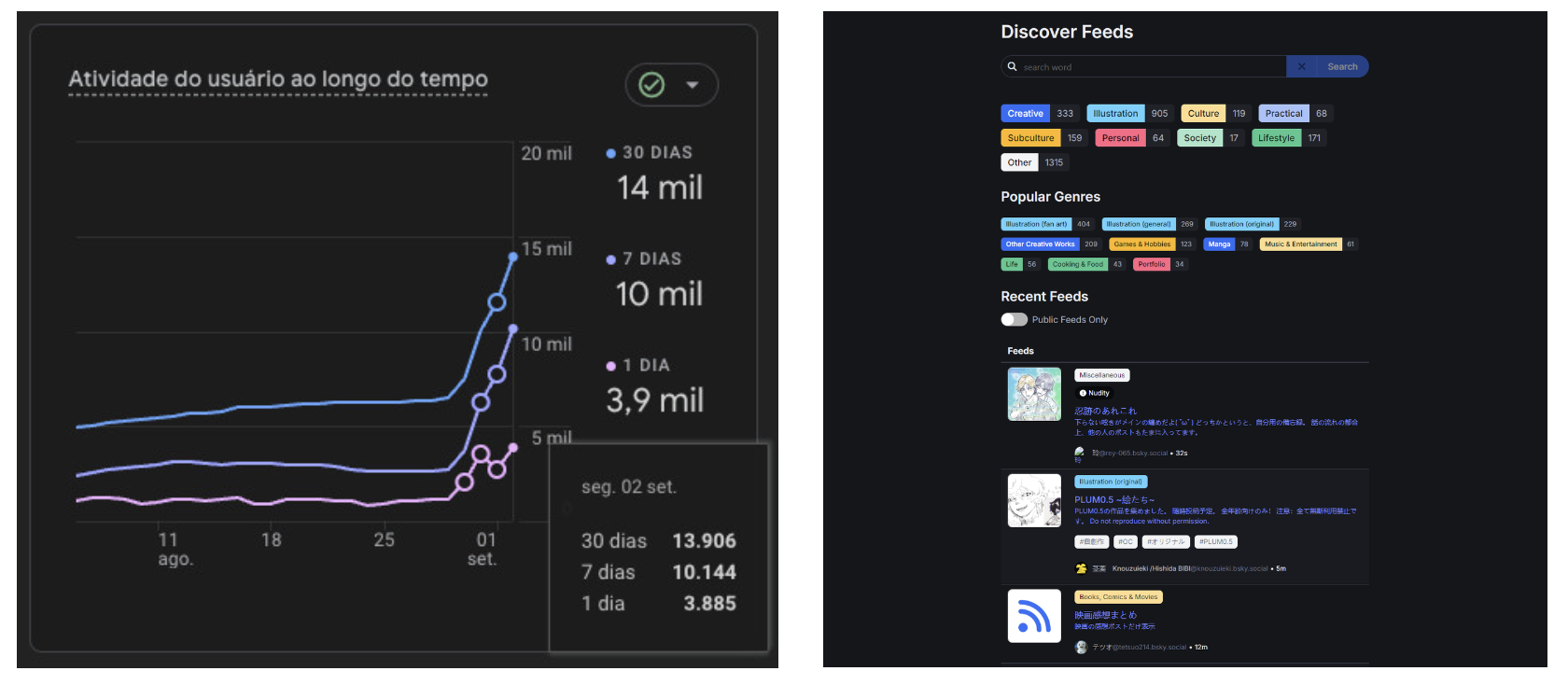
Product Features
Based on the summary of pain points of social media products, Bluesky and AT Protocol have provided a complete solution. Its main product features are as follows.
The first is the community-driven audit service. The shortcomings of centralized audit policies have been fully explained. Bluesky’s audit model is:
Users can delegate moderation rights to moderators they approve
You can customize user preferences for moderation, such as hiding rude posts, hiding screenshots, hiding spoilers, and even hiding all images containing spiders. Such customization options are constantly being enriched.
Different moderators are composable and can be used in combination
Bluesky’s community-driven audit model also has external interoperability and can be called by other applications in the AT Protocol ecosystem.
There are currently more than 100 moderation services in operation.

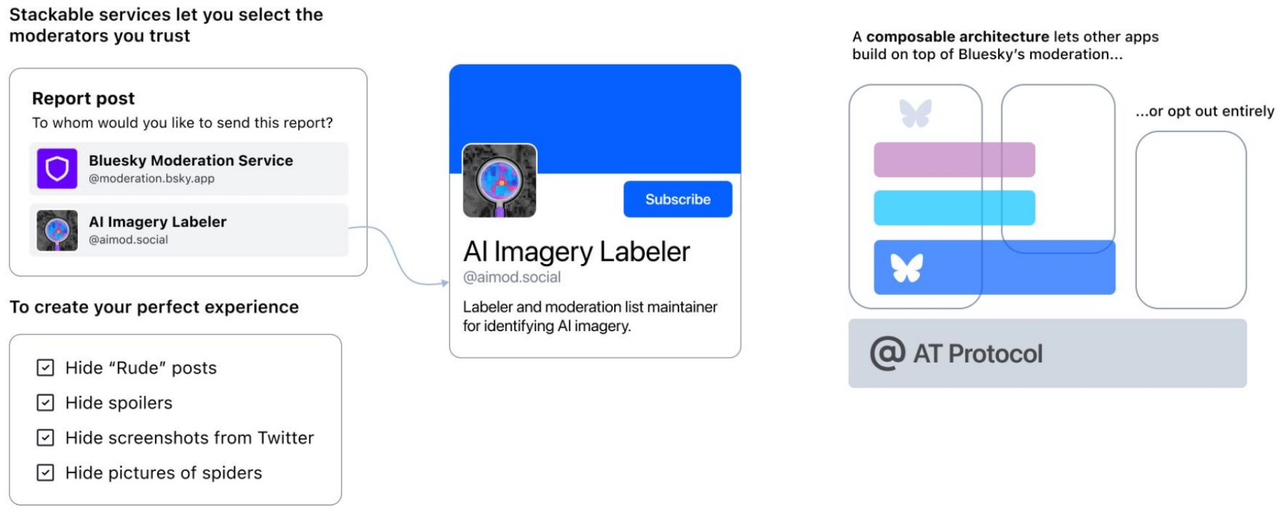
The second is the user-customized information flow. The information flow on the platform is created by various curators, and each curator has its own algorithm for the feed:
Some algorithms are relatively standard, such as information collected from experts and authors in a certain field, automatically crawling the most popular posts in the past 24 hours, etc.
Some algorithms are quite strange, for example, they aggregate content from bloggers who dont post very often.
The feeds created by different curators form a marketplace of algorithms, where users can choose and create their own algorithm-neutral content. According to data verification, such customized information flows can increase user retention by up to 2 times. If Bluesky launches a token economy in the future, curators with excellent curation capabilities are likely to become one of the key incentive targets, thereby further increasing the usage rate of custom feeds.
The third is the ownership of identity and data that belongs entirely to the user. Specifically:
The users identity and content are all owned by the user
The custom handle represents the users identity, which can be migrated across applications
User data is stored in a database that can be migrated
There are many obvious benefits to user identity and data ownership. In addition to being truly censorship-resistant and anti-regulatory in terms of technology, it also allows users to monetize their personal identity and data assets in terms of business models. This business model has been proposed for a long time, and it is gradually becoming possible with the development of technology.
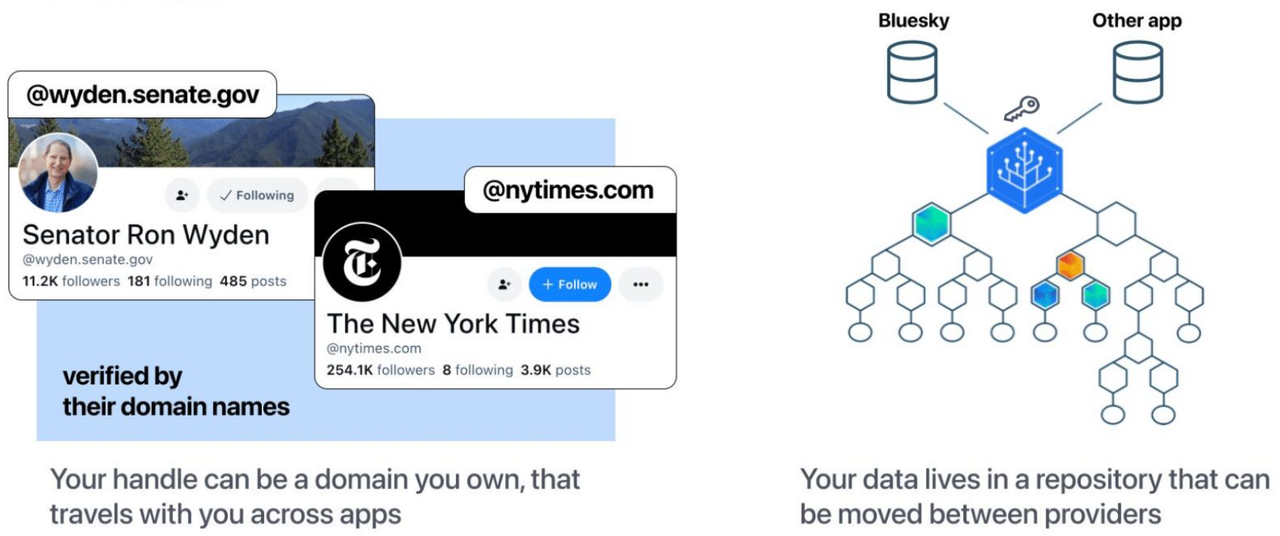
The fourth is the protocol-based development platform, which solves the problems of closed ecology, cold start dilemma, and high difficulty in development. The problem of social media platforms can be summarized as: users are locked in, and developers are locked out. Take Xs third-party client as an example. There used to be a large number of high-quality developers who developed third-party clients based on Xs API, such as Tweetdeck. There is also an equally large third-party Weibo client ecosystem in China, such as Weico. These clients brought a large number of users to X and Weibo with their innovative features, more beautiful UI, and better user experience (such as no ads), but in the end X and Weibo chose to close the API, which caused huge losses to third-party client developers.
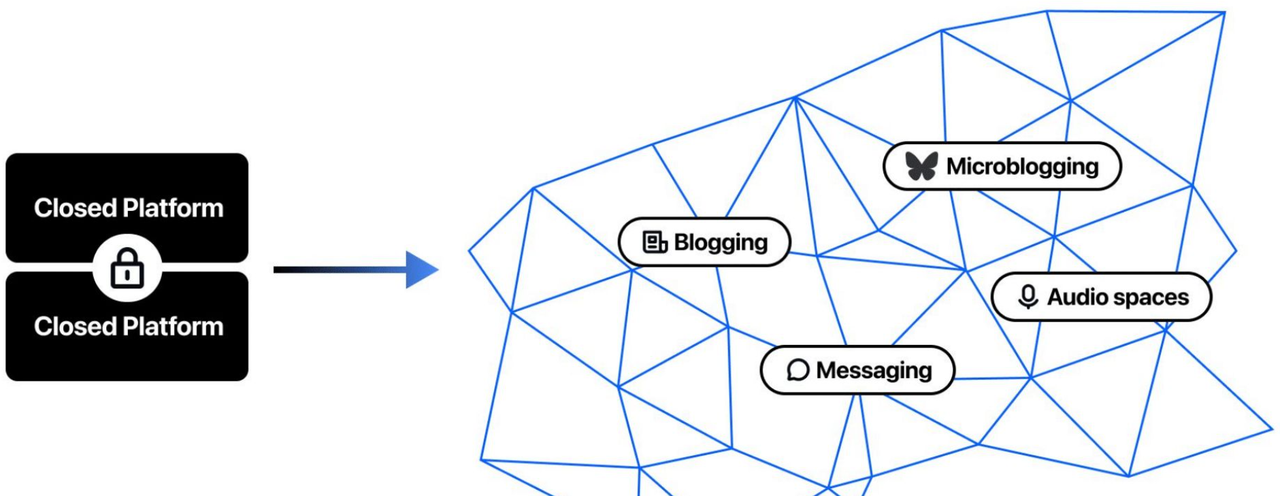
Blueskys AT Protocol advocates complete permissionless development. Developers can freely adjust any resources within the protocol, develop products with different functions, and become members of ATmosphere (AT Protocol ecosystem):
The user network of AT Protocol (including Bluesky) is shared, so developers do not have to perform a cold start that is too time-consuming, labor-intensive and costly.
Commonly used functions are abstracted and encapsulated into a complete toolkit, so developers can easily make composable calls.
Developers can also conduct composable development based on a single platform, add rich plug-ins, and possibly add support for tokens.
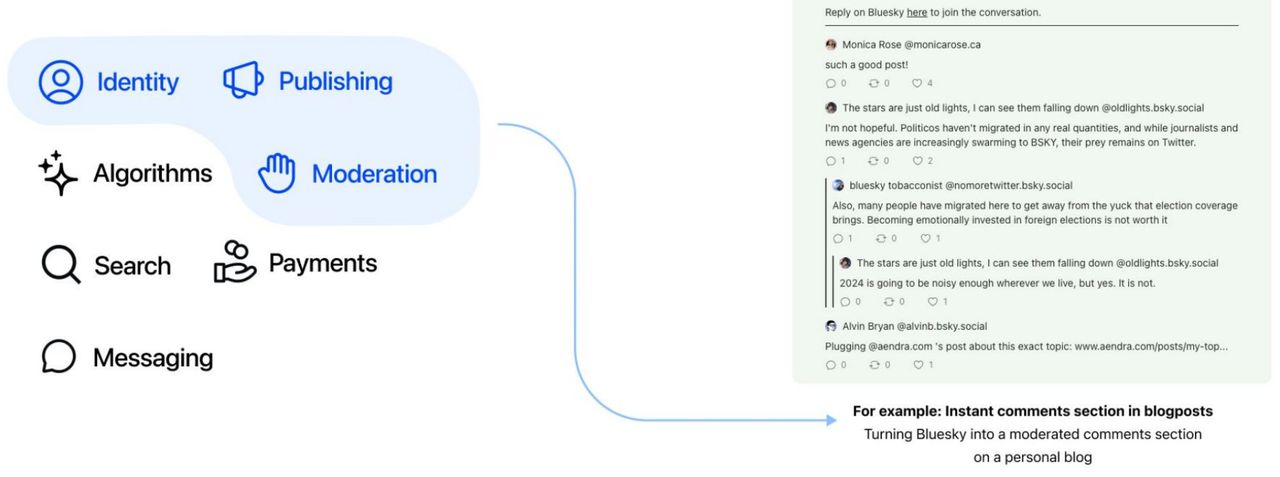
Bluesky collaborated with user @davis.social to create a comic that explains what makes Bluesky special.
In addition to Bluesky, there are several other protocol-based social products that have tried this, such as Farcaster, Lens, and Nostr, all of which have unique concepts.
Farcaster was founded in 2020 by Coinbase executives and is currently valued at over $1 billion, with investments from Paradigm, A16Z, and others. Farcaster chose a balanced solution on the on-chain/off-chain issue, maximizing performance while ensuring user data ownership. Farcaster launched its flagship application Warpcast in February 2024, which was welcomed and praised by Web3 degen users. The Frames development framework that was subsequently launched also attracted a large number of developers. At the same time, the success of the ecological meme coin $DEGEN also attracted a large number of users to Warpcast.
Lens was founded in 2022 by the founder of AAVE. It is currently valued at over $500 million and is invested by IDEO, Variant, etc. Lens is highly modular in its technical architecture and is very developer-friendly. It also proposed the concept of assetization of social elements with NFT as the core for the first time. Its open actions development framework also supports the realization of more personalized features. The Lens ecosystem currently consists of applications such as Phaver, Hey, and Orbs.
Nostr was founded in 2018 and also received funding from Jack Dorsey. Unlike Farcaster and Lens, Nostr does not support the token economy and does not plan to launch tokens. It is a minimalist P2P messaging system consisting of a client and a relay. Nostr has distinct features: simplicity, neutrality, and robustness, and users can run their own relays. Its ecological application Damus was launched in February 2023 and triggered a wave of enthusiasm, and many crypto users experienced it at the first time.
Before these protocols, believers in decentralized social networking began to make active attempts starting with Steemit in 2016. These products and protocols have been explored in many aspects such as technical architecture, token economy and developer introduction for more than 8 years, and have achieved remarkable results after going through ups and downs. However, they still face challenges in user acquisition and user network construction, and the number of daily active users has not exceeded 100,000. However, this is just the beginning. We hope that decentralized social products can explore different paths and eventually win the favor of users.
Interim Results
Blueskys data is surprising, this is a high-scoring interim answer sheet:
In terms of user data, Bluesky only had 30,000 users in April 2023, and in October 2024, its user base has exceeded 12 million, with a monthly growth rate of 38%, which almost replicates the rapid growth curve of major social media giants in their early days. Monthly active users and daily active users also exceeded 3.5 million and 2 million respectively, and the DAU/MAU ratio exceeded 45%, reflecting a fairly active user ecosystem.
In terms of user behavior, the DAU ratio of lurking users has gradually decreased, and the ratio of posting users has gradually approached half of the lurking users; 12 million users have brought a total of 440 million posts and 1.72 billion likes; 33% of users log in for more than 5 days in a week, and the user behavior data is healthy.
In terms of user distribution, American users account for more than 31%, Brazilian users account for more than 25%, Spanish users account for about 8%, Canadian users account for about 4.5%, and British users account for about 3.6%. These are all regions with relatively high user quality, and are gradually showing a diversified distribution. Currently, users in more than 20 countries are using Bluesky.
In terms of content and developers, Bluesky has generated more than 50,000 custom feeds, more than 100 moderation services, and more than 40 clients of various types, including Skyfeeds, Deck.blue, Whitewind, Bluecast, Fresky.tv, etc. Users and developers are actively building the ecosystem.
To some extent, the data obtained by Bluesky proves that it has found the right early growth flywheel, thanks to their clear GTM strategy. Bluesky adopts a similar approach to Reddit and Discord, using celebrities/KOLs as leverage to attract high-quality users of different niche topics, and using them as the main contributors of content to build an early high-quality content ecosystem for the platform: We already have a large amount of information flow and a lot of content flowing through the network. Unlike many decentralized social or crypto platforms, which usually cater to technical, crypto-focused audiences, we have thriving communities in various disciplines, including scientists, writers and artists, as well as fan groups like BTS. For example, Bluesky introduced the author of chiikawa, who has been popular for nearly two years, to the platform and updated comics on it, making it quickly become one of the accounts with the most fans in Japan, and the same is true for South Koreas BTS. Bluesky allows the content on the platform to be less serious, such as a lot of spoofs and memes full of chaotic energy (this is very similar to the early days of X), but the quality of KOLs and active users must be guaranteed so that the platform can effectively ferment during the early growth process.
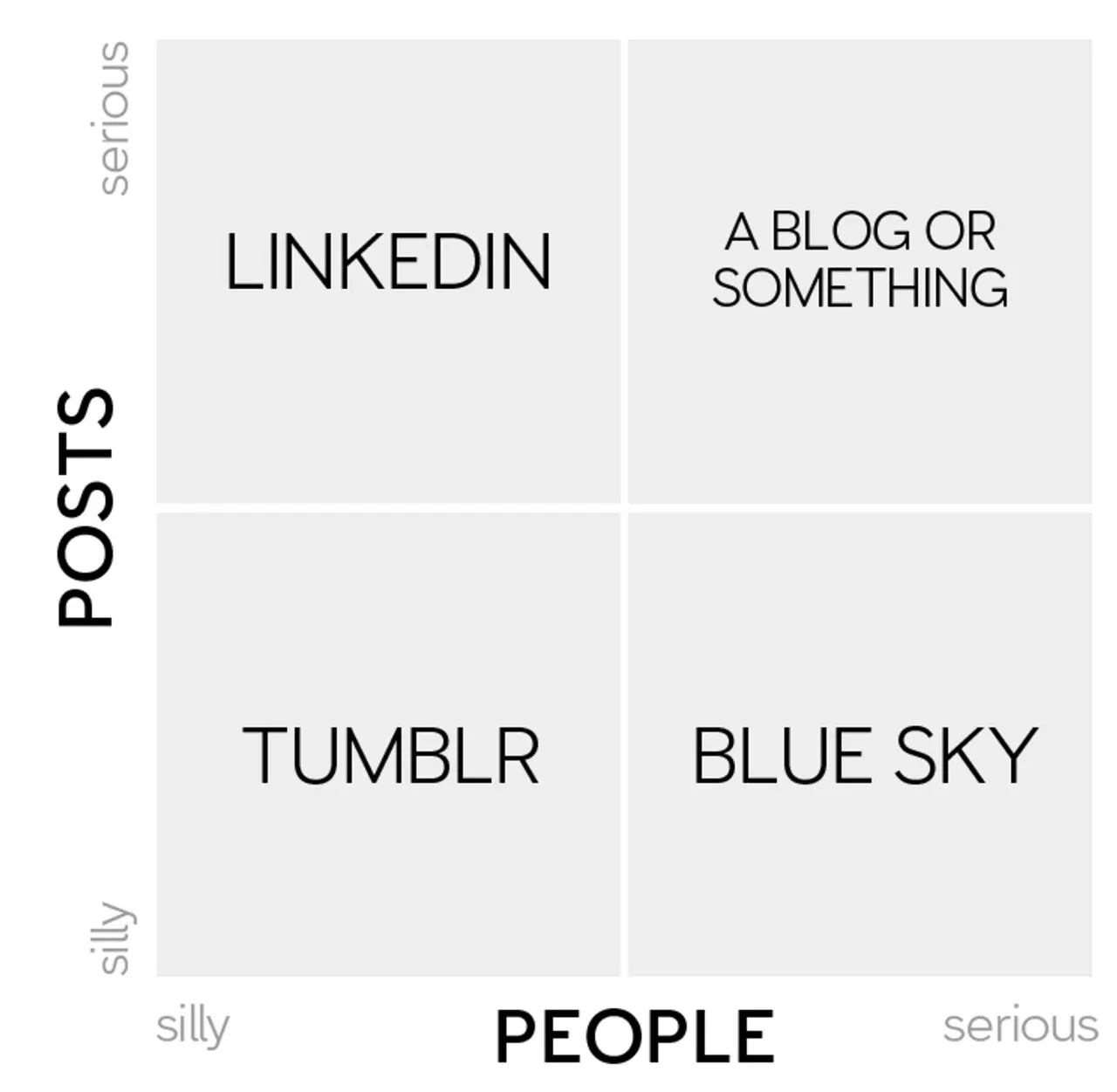
The Bluesky team is also very good at seizing unexpected opportunities. On August 30, 2024, the Brazilian Federal Supreme Court issued an order requiring the immediate suspension of Xs operations in Brazil due to Xs repeated failure to remove content deemed to violate Brazilian law and refusing to provide user data required for an ongoing criminal investigation. Bluesky quickly seized this opportunity, and as users continued to pour in, Bluesky became the hottest app in Brazil for a while, with a migration rate of 10% on the X platform. Brazilian President Luiz Inácio Lula da Silva also joined Bluesky. As one of the countrys most influential political figures, Lulas presence not only enhanced the credibility of the platform, but also hinted that Brazilian politicians and government officials might communicate with the public through Bluesky.
There are also a lot of novel operational levers in the works: “We envision exciting two-way embedded gaming platforms and opportunities for user engagement through gaming, especially during events like elections where they can make friendly predictions about each other. We’re actually driving quite a bit of the flywheel.”
Although Blueskys data is far behind that of social media giants such as X and Facebook, it has already achieved a considerable lead over other social protocols that are also protocol-based and Web3 native. The total number of users of several leading Web3 protocols is approximately between 500,000 and 600,000, with tens of thousands of monthly active users. Nostr, which has the highest degree of protocolization, has approximately 30,000 weekly active users and is still in the early stages of growth.
It can be seen that Blueskys is a decentralized social project whose data indicators are closest to centralized social. Bluesky also made it very clear that their benchmark is not Web3 social, but they hope to use products such as X and Instagram Treads as benchmarks. Their goal is to become a new generation of global popular social media.
In The Hero with a Thousand Faces, written by mythologist Joseph Campbell, the author raises a question: How does a hero become a hero? After refining and summarizing all the myths from around the world, Campbell summarizes the entire process of a heros journey from the start to the end of becoming a hero.
Among them, there is a link called The Belly of the Whale. The belly of the whale symbolizes a dark space full of uncertainty, and it is also the threshold of inward transformation. After experiencing the hardships in the previous section, the hero accidentally walked into the belly of the whale. In this dark area, he has to face his own fears and insecurities, gain the growth of inner strength, and constantly reflect in a state of absolute loneliness, constantly strengthen the goals of the journey, and prepare for the next adventure. In the end, the hero completes a transformation that is similar to rebirth, walks out of the belly of the whale, and becomes a more determined warrior.
Bluesky has gone through countless hardships and changes, and has achieved many remarkable milestones, including value establishment, personnel iteration, corporate operation, protocol construction, product cold start, etc. Although there are greater difficulties ahead, Bluesky has completed its rebirth from the belly of the whale.
4. There is always someone young
A young team with great value proposition
There is a famous Internet meme whose origin is unknown - the Three Laws of Technology the Three Laws of Society:
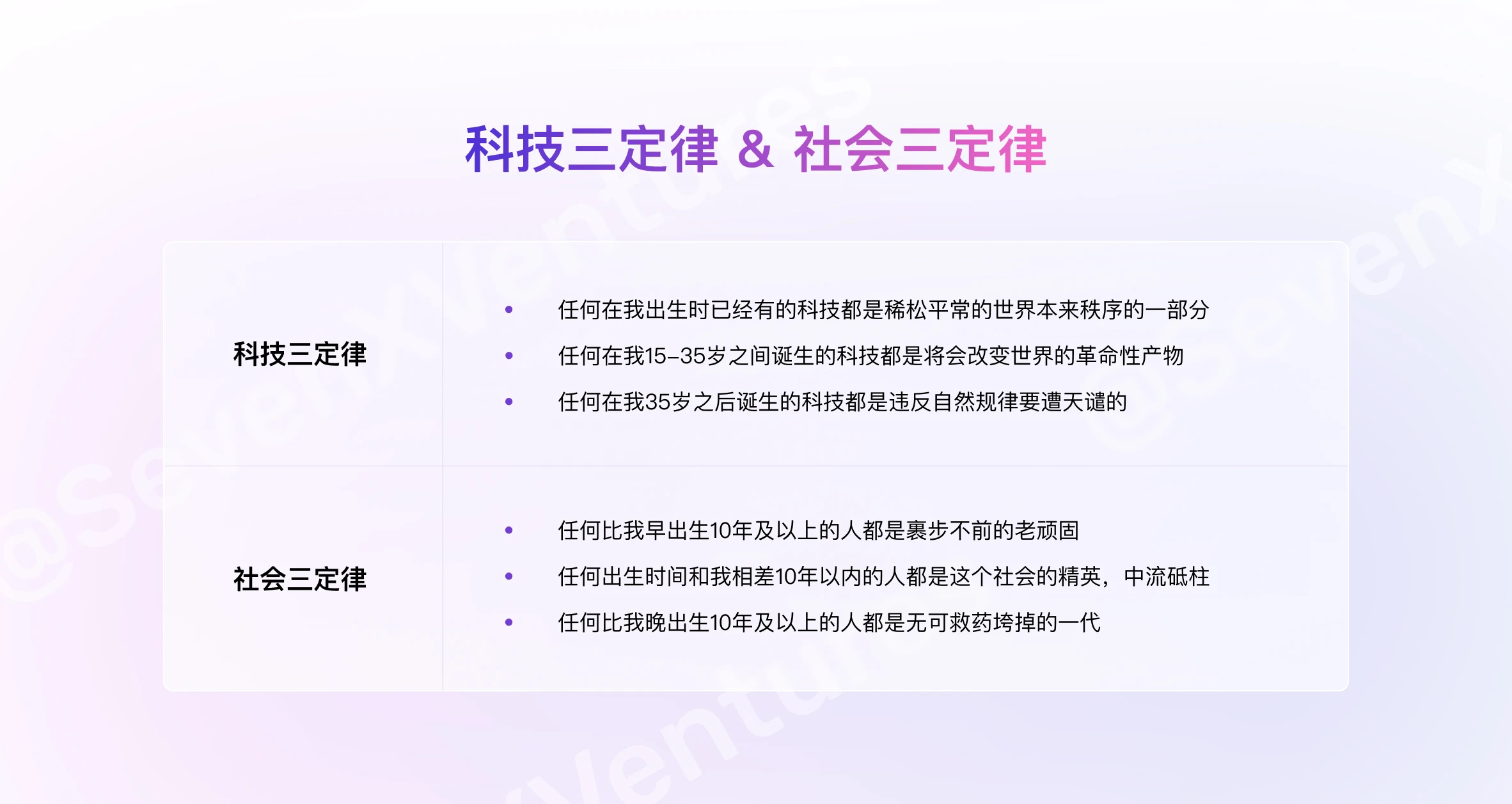
Social media is a feast for the eyes. Although these three laws of society still have doubts and ridicules for young people, we always believe in the new generation of teams. Bluesky is led by a core team consisting of Jay Graber, Rose Wang, Paul Frazee and Dan Holmgren. From multiple rounds of conversations with the team, we can feel that this is a young team with great style and value propositions, and strong long-term values.
Jay graduated from the University of Pennsylvania and has been the head of Bluesky since 2019. She has many years of experience as a software engineer and entrepreneur. Jay is also a senior digital rights activist who has focused on privacy and network neutrality movements since the early days of her career. At the same time, Jay also worked in a cryptocurrency mining company and several blockchain startups, and helped with the exit of Zcash.
When Jacky Dorsey started planning Bluesky, he spent two years selecting the right person in charge and finally found Jay. We spent about two years interviewing people who would build the protocol. We finally found Jay Graber. She looked great and we decided to fund her. Jay raised $14 million in funding from Jacky Dorsey.
Jay came from the center of the storm, but she showed great resilience. As Bluesky developed, continued financing, development, and growth became imminent, and she had to return to the corporate model, which was also the most important reason why Jack Dorsey withdrew from Bluesky. When Bluesky transformed from a fully open protocol to a physical company, although Jacky Dorsey expressed different opinions, he still maintained his recognition of Jay, I really respect Jay. She is under a lot of pressure to survive and do what she does. This is a CEO worthy of respect.
Roses experience is quite different. After graduating from Harvard University, she founded the food company Chirps and continued to run it for nearly six years. Later, she joined the AI startup Forethought to manage customer experience. During this period, she met Jay in the San Francisco entrepreneur community and decided to join Bluesky to use her offline community building experience. Rose is currently in charge of partner management and user growth at Bluesky. As a rare female entrepreneurial partner, we also feel the different gentle and firm strength of Jay and Rose, and we are very honored to support such a team.
Bluesky has a deep technical background, especially a strong open protocol gene. Chief Technology Officer Paul Frazee has five years of blockchain entrepreneurial experience. He founded Blue Link Labs and built Patchwork (the first application using the SSB distributed social protocol) and Beaker Browser (the first web browser supporting the Hypercore distributed web protocol). He later joined Bluesky as a protocol engineer and was promoted to Chief Technology Officer. Protocol Director Daniel Holmgren is one of the founding members of Bluesky and has experience in IPFS development at Fission. Daniel previously co-founded a Consensys-backed startup dedicated to p2p data transmission of scientific data sets.
Blueskys technical advisory team is equally strong, including: Jeremin Miller, inventor of XMPP; Martin Kleppmann, author of Designing Data-Intensive Applications and researcher at the University of Cambridge, Martin has been working with the Ink Switch team to publish cutting-edge research results on distributed protocols; Jeromy Johnson, the first employee of Protocol Labs, lead engineer of IPFS and Filecoin as well as other projects including Coinlist and Estuary; and experts from X and Meta who are committed to trust, security and developer experience, such as Amir Shevat (former head of development platform at X), Dan Abramov (former head of product at Facebook) and Yoei Roth (Trust and Security).
Bluesky’s potential
From an investment perspective, we believe that social media is a very special type of investment opportunity: it has the most efficient network effect, the largest coverage, and the broadest social influence. A single spark can start a prairie fire, and social media is one of the few high-quality non-technical trend investment themes.
Social media is a chaotic model, and no one can make effective predictions. We speculate that the potential of Bluesky may be in the following aspects;
a. A truly efficient open protocol ecosystem. Operate open protocols in a company-like manner, expand developers in the most efficient way and allow developers to compete widely, thereby giving birth to a large number of high-quality innovative projects (this is very similar to the way many Web3 native social protocols operate, and they have already tried a way to build an ecosystem)
b. The next generation of super apps. This could be Bluesky itself (currently leading the pack) or other apps from ATmoshpere. They will continue to iterate on core features such as custom feeds and moderation services, find the right PMF, and get the right growth flywheel.
c. Brand new business model:
The first is an effective incentive model. One of the main reasons for the gradual decline of early Internet protocols is the business model problem. Building and maintaining protocols has long been a struggle. Most of the work is usually done by volunteers, and over time, if not paid attention to, the protocol will atrophy.
The second is a challenge to the traditional advertising model, perhaps an advertising model based on more limited data, more focused on matching intent, such as Googles original advertising model that didnt rely so much on knowing everything about users, but on knowing what users were searching for on the Internet at a specific moment. Or you can go back to the more traditional world of brand advertising, where popular advertisers would look for the right community. For example, a card company wants to advertise within a micro-community that is interested in cards on a certain platform.
The third is the business model based on user data ownership, such as reverse auctions: users assetize their data and provide it to platforms, advertisers or other users in exchange for advertising access and transaction facilitation.
The fourth is the business model based on the token economy. The token system of Bluesky and AT Protocol is still under design, but two points can be confirmed: First, the value of the token is a reflection of the network effect of the protocol. As a protocol with more than 10 million users, the demand and value of its tokens have a solid foundation. Second, as a protocol token, it can well capture part of the commercial value generated by ecological applications. On top of this, Blueskys tokens may also be used as creator payments/subscriptions, as well as more imaginative financial payments within the platform, etc. Web3 native social protocols represented by Farcaster have made creative attempts in this regard.
Will protocol-based social media succeed? We dont know. Let me end with a quote from Masnicks book Technical Approaches to Free Speech: Changing the Economics and Digital Infrastructure of the Internet to Promote Free Speech: Over the past half century of network computing, the pendulum has swung between client-side computing and server-side computing. We went from mainframes and dumb terminals to powerful desktop computers to network applications and the cloud. Perhaps we will begin to see a similar pendulum in this space as well. We have gone from a world dominated by protocols to a world where centralized platforms control everything. Returning us to a world where protocols dominate platforms could bring huge benefits to free speech and innovation online. Such a move has the potential to return us to the early promise of the web: to create a place where like-minded people can communicate on a variety of topics from around the globe, and anyone can discover useful information about a variety of different topics without being polluted by abuse and false information. At the same time, it could promote greater competition and innovation on the Internet, while also giving end users greater control over their own data.
On March 22, 2006, Jack Dorsey posted the first tweet on the Internet, just setting up my twttr, which started a social media empire. 13 years later, on December 11, 2019, Jack posted another tweet, X is funding a small independent team of up to five open source architects, engineers, and designers to develop an open and decentralized standard for social media, which opened the self-iteration prelude of replacing platforms with protocols.
Four years have passed, and one of the batons has been passed to Bluessky, and everyone is looking forward to it. The predictions we can make are very limited, but this is the charm of social media products. We see that Bluesky is doing the right thing, and therefore look forward to Bluesky taking us to the unknown and further places.











